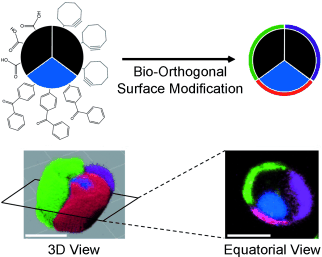3D construction: Microparticles made of three chemically independent patches

(Phys.org) —Micromachines, nanorobots, multifunctional drug transporters, and matrices for tissue growth – these and many other applications would benefit from three-dimensional microstructures that present different (bio)chemical ligands that offer control over directionality. In the journal Angewandte Chemie, a team of German and American researchers has now reported the production of microparticles whose surface consists of three separate areas ("patches") that can be decorated with three different (bio)molecules.
"While the spatially controlled presentation of chemical and biological ligands is well established for two-dimensional substrates, very few methodologies exist for the spatially controlled decoration of three-dimensional objects, such as microparticles," explains Jörg Lahann (University of Michigan, USA and Karlsruhe Institute of Technology). "Such structures would be very useful for many different applications, such as the controlled interaction of particles with biological cells for tissue growth." Organs are three-dimensional structures made of different types of cells. The growth of organs requires supports that stimulate the three-dimensionally controlled colonization of these cell types. Future technical applications, such as micromachines, will require 3D particles that can control the self-assembly of three-dimensional structures. If an area can also be made to respond to a stimulus by swelling or shrinking, for example, it would be possible to produce movable miniature components for use in sensors, robotic arms, or switchable drug transporters.
Lahann and his co-workers have now developed a method that allows them to obtain three chemically different patches on the same microparticle. The technique they used is electrohydrodynamic co-jetting, a process in which the researchers pump three different polymer solutions through parallel capillaries. An electric field accelerates the ejected liquid, which stretches it out. The solvent simultaneously evaporates, leaving behind a microfiber consisting of three chemically different compartments. By cutting the fibers, the team produces fine microparticles that are also made of three chemically different segments.
For their starting materials, the researchers chose three biodegradable polymers based on lactic acid. The three polymers were each equipped with a different chemical anchor group (known as "click functionality"). It was thus possible to attach different ligands, such as different biomolecules, to the anchor groups in an orthogonal fashion, meaning that the surface reactions to attach the ligands do not influence each other. By using biomolecules containing fluorescent markers, the scientists were able to demonstrate by using a microscope that three different patches were indeed present on the same microparticle. "For practical applications the particles need to be just a bit smaller – that is our next goal," says Lahann.
More information: Joerg Lahann. "Chemically Orthogonal Three-Patch Microparticles." Angewandte Chemie International Edition, dx.doi.org/10.1002/anie.201310727
Journal information: Angewandte Chemie , Angewandte Chemie International Edition
Provided by Angewandte Chemie




















